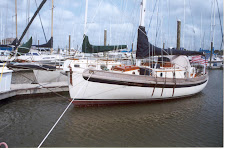When we take her to the river I want to step the mast, paint the boot stripe and leave, pronto. Stay too long at Hillman's and the shrimpers will steal the hubcaps off her. To make sure that operation goes smoothly I have decided to step the mast and rig up right were we sit. That means doing it twice but I think the dress rehearsal approach will pay dividends in the long run. With this in mind we pulled Rose out of the shed yesterday.
The small round piece of stained glass I bought from the hobby lady in Spring Branch was supposed to fit inside the port light over the chart table. I was short one bug screen anyway so seemed a good idea. It did not fit (measure once and buy it twice), so we made it a part of the forward cabin door instead. The idea unabashedly stolen from fellow BCCer, Stewart. Turned out to be a better use for this bauble of colored glass anyway.
.
The companionway doors turned out nice and the galley is shaping up. I can't believe I lost one of the brass hinges for the refrigerator door. As soon as I buy a new pair the lost one will turn up. Engine room wiring needs serious organizational (and labeling) attention.











